A tropical disturbance is born when this moving mass of thunderstorms maintains its identity for a period of 24 hours or more. This is the first stage of a developing hurricane.
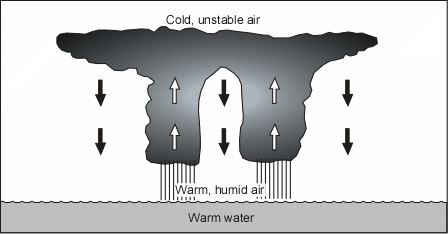
| EENS 3050 | Natural Disasters |
| Tulane University | Prof. Stephen A. Nelson |
Tropical Cyclones |
|
|
We have already discussed the factors involved in the circulation of the atmosphere and oceans. Knowledge of the general atmospheric circulation patterns, the Coriolis effect, and circulation around high and low atmospheric pressure areas, and the principles concerning the importance of water in transferring heat between the atmosphere and oceans from the previous lecture is essential for understanding the material in this section. |
Hurricanes (Tropical Cyclones) Tropical Cyclones are massive tropical cyclonic storm systems with winds exceeding 119 km/hr (74 miles/hour). The same phenomena is given different names in different parts of the world. In the Atlantic Ocean and eastern Pacific ocean they are called hurricanes. In the western Pacific they are called typhoons, and in the southern hemisphere they are called cyclones. But, no matter where they occur they represent the same process. Tropical cyclones are dangerous because of their high winds, the storm surge produced as they approach a coast, and the severe thunderstorms associated with them. Although death due to hurricanes has decreased in recent years due to better methods of forecasting and establishment of early warning systems, the economic damage from hurricanes has increased as more and more development takes place along coastlines. It should be noted that coastal areas are not the only areas subject to hurricane damage. Although hurricanes loose strength as they move over land, they still carry vast amounts of moisture onto the land causing thunderstorms with associated flash floods and mass-wasting hazards. Origin of Tropical Cyclones (Hurricanes)
|
|
 |
|
|
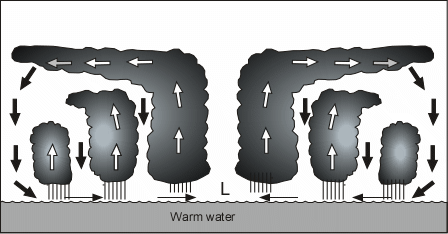 |
To undergo these steps to form a tropical cyclone, several environmental conditions must first be in place:
|
|
| Tropical Cyclones thus commonly develop in areas near, but not at the equator, as shown in
the diagram below. As they move across the oceans their paths are steered by the
presence of existing low and high pressure systems, as well as the Coriolis force. The
latter force causes the storms to eventually start turning to the right in the northern
hemisphere and to the left in the southern hemisphere. Note that about 12% of all tropical cyclones develop in the Atlantic Ocean. Those that begin to form near the coast of Africa are often referred to as "Cape Verde" hurricanes, because the area in which they develop is near the Cape Verde Islands. 15% of all tropical cyclones develop in the eastern Pacific Ocean, 30% develop in the western Pacific Ocean, 24% in the Indian Ocean both north and south of the equator, and 12% develop in the southern Pacific Ocean. It is notable that essentially no tropical cyclones develop south of the Equator in the Atlantic Ocean, although one occurred off the coast of Brazil in March of 2004. |
|
Tropical Cyclone Structure
|
| Because the converging winds spiral inward toward the central low pressure area, the winds rotate in a counterclockwise direction around the central low in the northern hemisphere (clockwise in the southern hemisphere). | 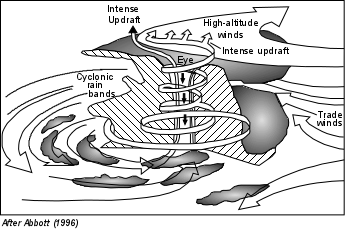 |
| As these winds spiral inward they draw in the thunderclouds around the storm, creating the spiral rain bands that are clearly visible on satellite images of the storm (recall satellite images of hurricanes that are seen frequently on TV during hurricane season). | |
| As the winds converge toward the central core, they spiral upwards, sending warm moist
air upwards. As this air rises, it cools and releases its latent heat into the
atmosphere to add further energy to the storm. The winds spiraling around this
central core create the eye of the tropical cyclone and eventually
spread out at high altitudes. Eventually, cool air above the eye begins to sink into
the central core. This dry descending air within the eye gives the core a clear,
cloud free sky, with little to no wind. Since the main source of energy for the storm is the heat contained in the warm tropical and subtropical oceans, if the storm moves over the land, it is cut off from its source of heat and will rapidly begin to dissipate.
Winds
spiraling counterclockwise (in the northern hemisphere) into the eye of the hurricane
achieve high velocities as they approach the low pressure of the eye. The velocity
of these winds is called the hurricane-wind velocity. |
|
Thus, when we consider the velocity of winds around the hurricane we must take into account both the wind velocity and the storm center velocity. Depending on the side of the hurricane, these velocities can either add or subtract. In the example below, the hurricane is traveling north with a storm center velocity of 30 km/hr, and a hurricane-wind velocity of 150 km/hr.
On the right hand side of the storm both velocities are to the north so the total wind velocity is 180 km/hr (30 + 150). On the left hand side of the storm, however, the wind is blowing to the south. Thus, since the storm is moving in the opposite direction to the winds, the velocities subtract and the total wind velocity is 120 km/hr (150 - 30). |
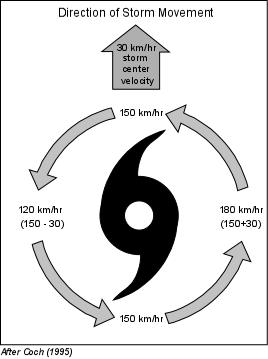 |
|
This is an important point. Winds are always stronger on the right side of a moving hurricane in the northern hemisphere. (The opposite is true in the southern hemisphere, since winds circulate in a clockwise direction, the winds are stronger on the left-hand side of the storm in the southern hemisphere). |
Tropical Cyclone Size The smallest, Tropical Storm Marco, had tropical storm force winds that only extended 19 km in radius when it struck Mexico's Gulf coast in 2008. There is very little association between hurricane intensity (either measured by maximum sustained winds or by central pressure) and size. Hurricane Andrew is a good example of a very intense tropical cyclone of small size. It had 922 mb central pressure and 230 km/hr sustained winds at landfall in Florida, but had tropical storm force winds extending out to only about 150 km from the center. |
Hurricane Intensity and Frequency |
Saffir-Simpson Hurricane Damage-Potential Scale |
||||
Scale Number |
Central Pressure |
Wind Speeds |
Storm Surge* |
Observed |
| 1 | >980 (>28.94) |
74-95 (119-153) |
4-5 (1.2-1.5) |
some damage to trees, shrubbery, & unanchored mobile homes |
|---|---|---|---|---|
| 2 | 965-979 (28.50-28.91) |
96-110 (154-177) |
6-8 (1.8-2.4) |
major damage to mobile homes; damage buildings' roofs, & blow trees down |
| 3 | 945-964 (27.91-28.47) |
111-130 (178-209) |
9-12 (2.5-3.6) |
destroy mobile homes; blow down large trees; damage small buildings |
| 4 | 920-944 (27.17-27.88) |
131-155 (210-249) |
13-18 (3.9-5.5) |
completely destroy mobile homes; lower floors of structures near shore are susceptible to flooding |
| 5 | <920 (<27.17) |
>155 (>250) |
>18 (>5.5) |
extensive damage to homes & industrial buildings; blow away small buildings; lower floors of structures within 500 meters of shore& less than 4.5 m (15 ft) above sea level are damaged |
| *Note that surge level is highly dependent on such factors as the recent history of the storm, the shape of the coastline, and the bathymetry of the sea floor along the coast. The numbers in this column should be considered minimums and be used with caution in predicting storm surge levels. | ||||
There are five possible categories. Category 1 storms are more common than category 5 storms. In a typical year, there may be many category 1 storms, but category 5 storms occur very infrequently. In 2010 the Saffir-Simpson scale was modified and simplified. Many years worth of data collected by the National Hurricane Center provided much evidence that many other factors control the height of the storm surge besides wind speed. Such factors as storm size (radius), shape of the coastline, and topography of the sea-floor are sometimes more important. Furthermore, the data did not show a good correlation between wind speed and central pressure. Thus the current version of the Saffir-Simpson Scale is based solely on wind speed and the central pressure and storm surge information is not part of the scale. |
| Again, because a hurricane derives its energy from the warm ocean waters in the topics and subtropics, hurricanes are more frequent in the late summer months. Thus, as seen in the graph, hurricanes in the Atlantic ocean are more frequent in the months of August, September and October. The peak occurs on September 10. Very few have been recorded in January through April. | 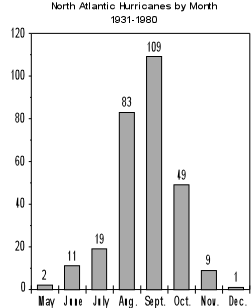 |
Monitoring and Tracking Hurricanes
|
|
| Changes in Hurricane Tracks and Intensities Because hurricanes are influenced by large-scale air masses, they sometimes move along rather erratic paths. Hurricanes are especially influenced by the strength and direction of upper level winds. As noted above, strong upper level winds create a vertical wind shear that cause the top of the hurricane to be sheared off and result in the loss of strength of the storm. The erratic nature of a hurricane's path often makes it difficult to predict where and when it will make landfall prior to several hours before it actually does make landfall. In the lower latitudes, near the equator, hurricanes generally are pushed by the easterly trade winds and have storm center velocities that are relatively low (8 to 32 km/hr). As they move northward, storm center velocities generally increase to greater than 50 km/hr. |
| This increase in storm center velocity usually results from the interaction of the storm with other air masses. Off the eastern coast of the United States there is an area of semi-permanent high pressure, known as the Bermuda High. Other high pressure centers are continually moving eastward off of North America. If the hurricane encounters a low pressure trough between two high pressure centers, it is steered into the trough and follows it along a northeastward trend, increasing its velocity as it does so. | 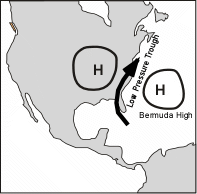 |
| Interaction with the land and other air masses are most
responsible for changes in hurricane tracks and intensities. Some
examples are shown on the map below. Two of the most erratic hurricane paths
recorded are shown by Hurricane Betsy, in 1965 and Hurricane Elena in 1985. |
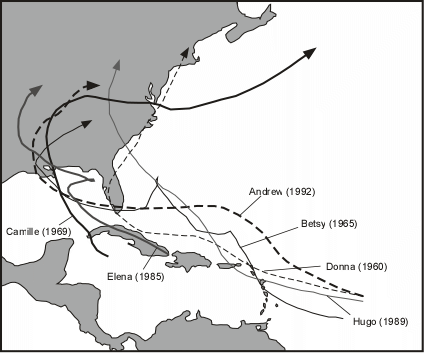 |
|
|
|
Angle of Hurricane Approach to Coast |
|
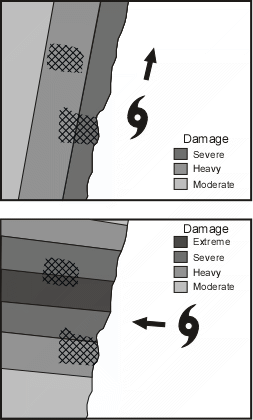 |
Hurricanes with a coast-parallel track have the additional danger that small shifts in course make landfall forecasts difficult. Because of such problems, forecast maps from the National Hurricane Center no longer show the line in the center of the forecast storm track.
|
Storm Surge
|
|
| Hurricane Katrina, in 2005, produced a 8.5 m (28 ft) storm
surge along the Mississippi Gulf coast even though it was a category 3
hurricane when it made landfall. This high storm surge was due to the
fact that only 24 hours before landfall it had been a category 5 hurricane
and the water pushed in front of it was trapped along the Louisiana coast to
the west where it could not escape, and to the fact that Katrina was such a large storm.
Because the storm surge occurs ahead of the eye of the storm, the surge will reach coastal areas long before the hurricane makes landfall. This is an important point to remember because flooding caused by the surge can destroy roads and bridges making evacuation before the storm impossible.
|
|
Since thunderstorms accompany hurricanes, and these storms can strike inland areas
long before the hurricane arrives, water draining from the land in streams and estuaries
may be impeded by the storm surge that has pushed water up the streams and
estuaries. |
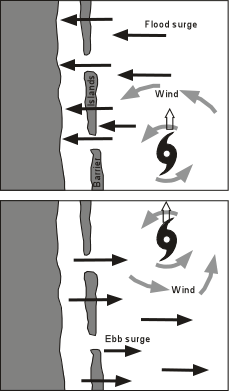 |
Hurricane Damage
|
Category Relative Damage
Median Damage (1995 Dollars)
1 1 $33 million 2 10 $336 million 3 50 $1.4 billion 4 250 $8.2 billion 5 500 $5.9 billion
Source: National Hurricane Center - http://www.aoml.noaa.gov/hrd/tcfaq/D5.html
| Predicting Hurricane Frequency and Intensity As discussed above, modern methods of weather forecasting involving satellites, radar, etc. allow accurate tracking of the development and paths of hurricanes. In addition, computer models have been developed by the National Weather Service that enable the prediction of storm surge levels along the U.S. coast, given data on wind velocity, wind distribution, and storm center velocity. These models were accurate to within about 1 foot for the levels of the storm surge that accompanied Hurricane Hugo along the South Carolina coast in 1989 and Hurricane Katrina in 2005.. Computer models have also been developed to predict the paths the storms will take and have met with moderate success. Accurate forecasting of storm tracks is more problematical because of the numerous variables involved and the erratic paths hurricanes sometimes take. Still the National Hurricane Center's accuracy of hurricane tracks has improved steadily over the last 25 years. As of 2002, the average error on a 24 hour forecast is - 80 mi., on the 48 hour forecast - 110 mi., and on the 72 hour forecast - 230 mi. Prediction of hurricane intensity (wind speed) is more problematic as too many factors are involved. Hurricanes are continually changing their intensity as they evolve and move into different environments. Without the ability to know which environmental factors are going to change, it is very difficult to expect improvement on intensity forecasting. Hurricane Katrina was expected to loose intensity as moved out of the warmer waters of the Gulf of Mexico. But, it showed a more rapid drop in intensity just before landfall because a mass of cooler dry air was pulled in from the northwest. |
| Some progress has been made in predicting the number and intensity of storms for the
Atlantic Ocean by Dr. William Gray of Colorado State University. He has shown that
there is a correlation between the frequency of intense Atlantic hurricanes with the
amount of rainfall in western Africa in the preceding year. This correlation has allowed
fairly accurate forecasts of the number of storms of a given intensity that will form each
year. The 1997 predictions, however, did not take into account the effects of El
Niņo, which reduces the number of hurricanes. Nevertheless, Dr. Gray's predictions are
closely watched, and have been otherwise fairly accurate.
Reducing Hurricane
Damage
|
Examples of questions on this material that could be asked on an exam
|